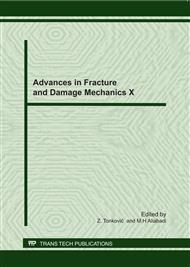p.573
p.577
p.581
p.585
p.589
p.593
p.597
p.601
p.605
Elastic-Plastic FEM Modelling of the Single Overload Effect on the Fatigue Crack Front Shape
Abstract:
A 3D elastic-plastic FEM model for prediction of planar fatigue crack growth is presented. The model is based on the concept of local low-cycle fatigue of a small material volume in front of a high cycle crack. A local crack front advance is modelled by the successive release of finite element mesh nodes in the plane of propagation. The release of the nodes is controlled by the value of the Smith-Watson-Topper fatigue damage parameter in the surrounding elements. The effect of the single tensile overload on the fatigue crack growth and on the fatigue crack front shape is modelled.
Info:
Periodical:
Pages:
589-592
Citation:
Online since:
September 2011
Authors:
Price:
Сopyright:
© 2012 Trans Tech Publications Ltd. All Rights Reserved
Share:
Citation:


